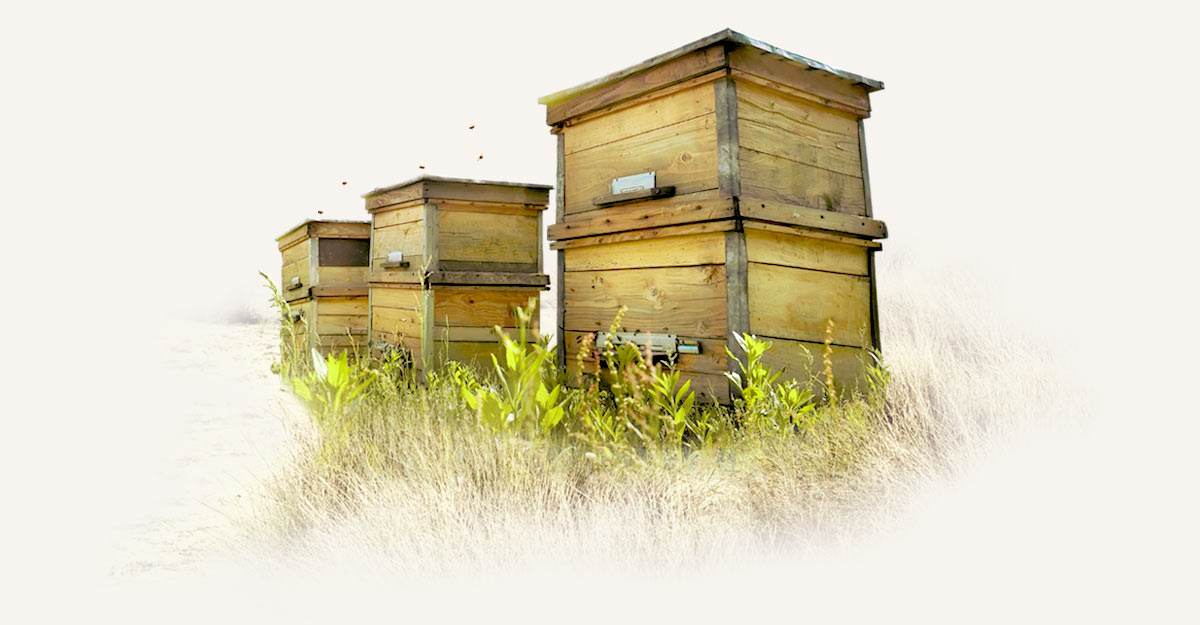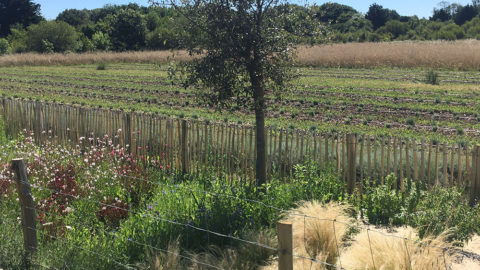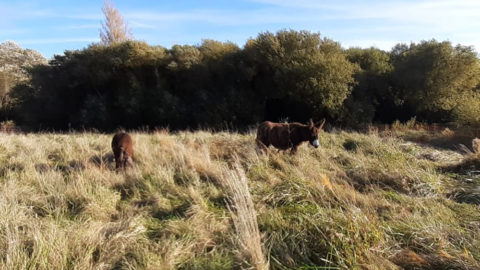©André Fiquet
Melifera is committed to protecting the black bee
Meeting with Zachary Gaudin *, coordinator of CANO (Association du Conservatoire de l’Abeille Noire Oléronaise)
By Laurence Froger
Since its creation, Melifera has demonstrated a strong commitment to nature and biodiversity. Partnering with the Black Bee Conservatory in Oleron immediately made sense for its creators. Zachary Gaudin, in charge of its development and coordination, introduces us to this world through a guided and argumented tour.
What exactly is the conservatory of the black bee ?
A delimited perimeter in which we tend to have only black bees. It is also an association of beekeepers from the island d’Oleron who, for the past ten years, have been working on protecting the local black bee against the first signs of hybridization. The island of Oleron’s Community of Communes, touched by this cause, first decided to participate in financing and setting up an educational apiary, the ‘Allards apiary’ in the municipality of Dolus. This led to the birth of the Black Bee Conservatory in the island of Oleron in 2018 also supported by the island’s community of communes. The conservatory is structured around beekeepers who care for the preservation of this specific bee race (we talk about race here as the black bee is a subspecies, Apis mellifera mellifera). They then created the Oleron Black bee conservatory association (CANO) and put in place the means to work on the discrimination of black colonies and the extraction of hybrid colonies from the conservation area. According to a predetermined cartography, the conservation zone is located in the north of the island, where the presence of the black bee is most important, the south being reserved to hybrids.
Is the black bee a race we can only find in Oleron?
No, we can find her everywhere in western Europe, in the north of the Alpin Arc, from the Urals to our country. We can however talk about a regionalization, meaning this subspecies has adapted to local environmental constraints. The notion of regionalization is not one strictly defined by geographical borders, rather by climate and wildlife factors. These bees are not necessarily used to very cold winters thus can adapt to periods of extreme drought as well as fairly short periods of bloom in our semi-Mediterranean universe.

How can we recognize a black bee ?
Well first of all, she is black! It is a rather large bee, black and furry. However not all black bees are part of the Apis mellifera mellifera race. Other races do exist, like the Caucasian you can find in Europe and Asia, black too but with very different characteristics that are not visible to the eye. To be sure you are seeing an Apis mellifera mellifera there are only two solutions: a genetic analysis and a morphometric analysis. The latter we used with the beekeepers to distinguish the colonies.
What are the characteristics of the black bee, and its lifestyle ?
The black bee is wild ,more rustic, more able to adapt and respond to environmental constraints. She is able to regulate the size of her colonies to conserve energy. This means a beekeeper will have to feed the subspecies less. When agricultural practices are respectful, there is no problem as the feeding doesn’t intervene exceptionally in cases of drought or very cold winters. The Black bee also has characteristics of adaptability and tolerance to different pathogens. She will be able to regulate her hive more precisely as she has better management of her brood. Nature has more space, and the bees are healthy, enabling this process to be viable..
Is the black bee’s reputation of being more aggressive a reality ?
No, the black bee is not more aggressive than any other bee. 30 to 40 years ago no one questioned the aggressive nature of the black bee and everyone worked with her. From the moment hybridization started, aggressive characteristics emerged. What we need to understand is that a bee, in certain periods of its life, is bound to have more aggressive behaviours. If there is thunder, if it is cold, if she has to defend herself, if she is weak, she will act in a way that is more aggressive as she needs to defend her colony. As this may be the case in certain moments, it is not the case all the time. We usually do not work without gloves, but it is possible in certain cases to manipulate the bees bare handed. It is absolutely plausible to approach the black bee hives without incidents. Again, aggressive behaviour stems from hybridization.
Is honey from a wild bee different ?
I challenge anyone to differentiate the honey from the black bee, to the honey from another bee. Let’s just say what will differentiate the black bees in the conservation context – because sadly we can only find them in conservation zones – is just different agricultural practices. We have sedentary hives. We are not going to do transhumance, we are not going to follow the monocultures of the rapeseed or sunflower type… we will leave apiaries in place and the bees will go naturally towards a set of flowers which will give honeys that are not typical but all flower honeys with peculiarities according to territories.
Why is it important to have a conservatory dedicated to black bees ?
Forty years ago, before humans decided to hybridize and import different races, the black bee was the only bee residing on the island of Oleron. Hybridization is used to select characteristics that are lacking in a specific race, characteristics that usually increase efficiency and docility. The second aspect of hybridization is looking for the heterosis effect. What is the heterosis effect? Take the example of buying a tomato in a store that is not biological or conservative free, there is usually written F1 on it. This means it is the first hybrid between two clearly identified lineages. It is this first hybrid that has the heterosis effect, it is more productive but if you planted its seeds the process ends. This is mainly due to the fact that the heterosis effect is only going to occur during this first hybridization. Breeders played this game for years until we arrived to the current situation, which is the loss of all genetic markers and the total disappearance of some genetic traits. This is because when we make a selection based on criteria of productiveness and docility, we do it quickly, and we will direct the disappearance of entire DNA sequences or even parts of chromosomes which are much more related to adaptive abilities. By doing this since decades, we are striping adaptive traits to a species who will become dependent on human beings.

©CPIE
Conserving, is thus acting to save with a real urgency, no ?
Conserving is above all trying to dampen the damages. If we don’t act now in 10 years there will be no more black bees to save. Only hybrids will be left. We all know, that if bees and pollinators disappear, we are heading towards a clear diminution of the human population and a major part of biodiversity. It may sound a little idealistic because what we are posing is that hybridized or not they remain bees that will be kept in boxes. This is simply because the races, the subspecies, they are hybridized with are not suited for our land. We will have higher winterly mortality rates, a larger feeding need and we will make these bees either dependent, either doomed to disappear. The goal of beekeeping is assisting entirely colonies, changing queens every year and completely selecting species to avoid having species that aren’t clearly defined. This is all but natural and this can only create a larger fracture in biodiversity, like the one we are currently experiencing.
Is the black bee particularly important to protect ?
Bees are the symbolic symptom of new agricultural practices. We now know that since 10 to 15 years bees have been endangered due to the use of pesticides that destroyed ecological niches in which they could develop naturally and build colonies Currently there are hardly any old trees, no more hedges the old ones cut to create hollow trees and fewer old buildings. There are hardly any spaces left apart from these wooden boxes which make the colonies for the assisted. It is thus necessary to let nature reclaim it’s right. This is why nature created a subspecies such as the black bee, which is adapted to our environmental conditions. What we wish to do in the conservatory, is to give sufficient space for this subspecies, so that she can continue to adapt. We are working with hives and although we maintain a sanitary activity to prevent manmade pathologies from developing even more, our beekeeping technologies are respectful: less interactions, less intrusions, and less harvests.
How does a black bee conservatory work ?
For a conservatory to work, it must be assumed that a queen will be fertilized by 10 or 20 males. To meet this need for fertilization, males can travel up to 6 km. So, to be able to orient these fertilization zones, we have no other choice than to delimit an area of 7 km where we will concentrate all the black colonies, with inside a small area of 3 km. In this space called the heart zone, or sanctuary zone, the colonies are allowed to follow a Darwinian evolution when possible, with enough beekeepers committed to the principal. The complexity is therefore to find an area where we will prevent beekeepers who work with hybrids from entering, and where we will give those who are already established solutions to be able to work ‘in black’. This is the problem for all conservatories in France.
Do you have other specificities concerning other conservatories in France ?
Firstly, we are located on a rather large island, which has primary production, thus, potentially melliferic qualities that we wouldn’t find on smaller islands. Secondly, we have the implication of local policies and the support of the community of communes to see this project come to life. Another particularity is our recent adhesion to the European Federation of
the Black Bee Conservatory that were groups a dozen conservatory’s in France. The FEDCAN enables us to work on communal problematics with widespread communication means to be more influential on the decisions that are currently being taken about the bees’ futures and the beekeeping world.

©CPIE
Making mentalities evolve, enabling the larger public to question conservation, is also reliant on informing yourself ?
Of course! Regulations will not cause evolution, but comprehension will. We need to give the means to the greater public so it can understand what we are doing, why we are doing it, and why it is urgent. It is transitioning from solely being a consumer, to being an actor. It is essential to understand the utility of conserving local species such as the black bee like we have already done for goats, turkeys, or bulls. A real natural and cultural heritage. It is remembering that our elders worked with these species 100 years ago and that with these species, they created the practices from which our current practices stem. If we forget this, we can just as easily forget all the operations that have led to our current cultural construction.
How do your communication actions translate on the field ?
We work with the community of communes to organize a lot of events such as setting up dedicated signage, organizing conferences and film debates led by scientists such as Lionel Garnery, a black bee specialist. We also have two shared apiaries where half days of explanation of beekeeping and the conservatory are organized. We also meet the general public at local and national events to exchange, raise awareness, while respecting the preservation of common goods.
Melifera decided to support the CANO. What are the implications of the brand for the protection of black bees on the island of Oleron?
It all started when Christophe Amigorena met the collective looking for a place to make immortelle flowers grow and then distill in Melifera gin. My meeting with Christophe immediately animated me. I was amazed by his will to create a brand carrying joint values and defending communal well-being. Melifera is a gin issued from biological agriculture, made with local products. It is also the will to be implicated at the heart of environmental protection projects on the territory of Oleron, financed of course by the brands profit. The link between Melifera and the black bee conservatory was easy to make, and the name matches really well! In its first year, Melifera financed an entire set of genetic analyses, that enabled the collection of 150 samples and genetic analyses of hives already present in the conservatory. It is for us an amazing opportunity to have a clear idea of the impact our work has had in the last three years. It is also an obligation to be able to meet the specifications of the black bee conservatories that belong to the FEDCAN.
Before arriving on the island of in 2016, you used to work in a plant biology laboratory at the university of Nantes. As a biologist what do you want to achieve through this conservatory?
Regarding the conservatory the goal is for every beekeeper in the north part of the island to naturally come to the conservatory. Any biologist, is necessarily sensitive to this notion of conservation. It is important to remember to leave space to nature. My motivation? Having the opportunity to participate in the conservation of a specific species and acting on our level so that the current biological crisis we are facing halts or even comes to a stop.
* Zachary Gaudin is the project manager within the CPIE Marennes-Oleron, in charge of the development and coordination of the Black Bee Conservatory of the island of Oleron on behalf of and with the financial support of the Community of Communes of the Ile d’Oleron.
Zachary Gaudin works with Ethel Gauthier. They are both responsible for the development and coordination of beekeeping projects in Oleron (conservatory and educational apiary of Allards).
The Community of Communes of Oleron is an honorary member of CANO (association of the Conservatory of the Black Bee of Oleron). As such, Zachary and Ethel, in charge of the technical implementation of a policy given by elected officials, participate in the life and operation of CANO



